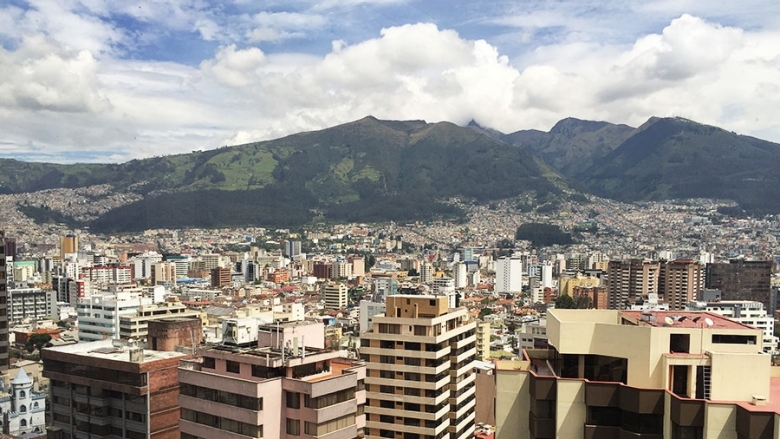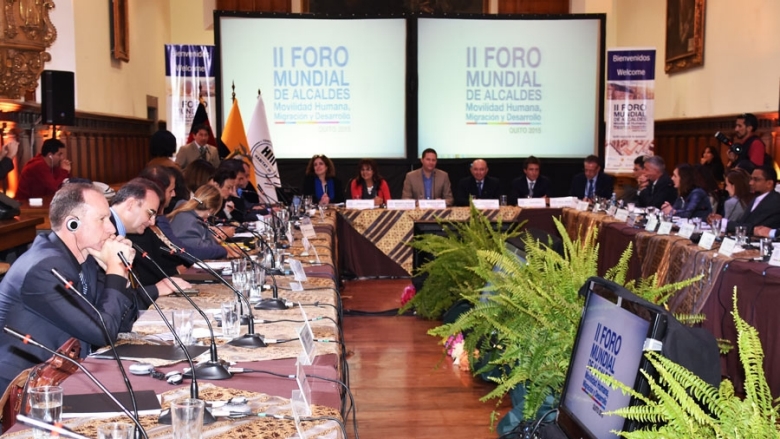With a population of approximately 50,000, the Costa Rican town of Upala, on the border with Nicaragua, is a town formed by the migratory influx.
Upala’s mayor, Alejandro Ubau, who participated in the Mayors’ Forum on Mobility, Migration and Development last week in Quito, Ecuador, believes that “no matter where they are from, everyone who lives in a territory is an agent of development and therefore should have access to basic services and to healthcare and education; otherwise, development does not exist.”
The experiences of municipalities like Upala, as first receivers of migratory flows and as entities responsible for policy making in service provision, supporting the integration of migrants, their inclusion in society and helping them find work, were discussed at the two-day Forum (November 12 -13).
Faced with a continual influx of migrants and refugees, how can cities prepare themselves to receive these people and provide them with the necessary services? What are the new challenges in terms of migration? How can the private sector and civil society work together to promote diversity and inclusion and how can they contribute to the integration of migrants and their incorporation into the labor force?
The main message of the Annual Mayors’ Forum was that migration is a positive phenomenon and that cities attract migrants.
These and other issues were at the center of discussions during the forum, which brought together more than 40 local government leaders and officials from around the world.
Mauricio Rodas, Quito mayor and host of the event, said that “for decades, cities have been key actors in human migration processes. Today is no exception. To the contrary, we have complex migratory phenomena in different parts of the world and many of them have not been adequately managed.”
“The challenge is to make cities places of opportunity for those who migrate,” he said.
Migration as a key for development
For Sonia Plaza, a senior economist at the World Bank, migration is a crosscutting issue that should be included in all development actions.
The World Bank, through the Global Knowledge Partnership on Migration and Development (KNOMAD), addresses migration from a development perspective, with the awareness that migrants are human beings that contribute to the development of their home countries as well as that of the countries that receive them. “Migration contributes to reducing poverty, promoting economic and social development and exchanging knowledge, technologies, trade and investment operations for both destination and home countries,” said Plaza.
Remittances are just one example of this: they have an impact on the lives of those who migrate and on the families migrants left behind at home, and finally on the economies involved. A country’s diaspora also contributes to economic development, not only through remittances but also through the creation of businesses for migrants abroad who establish trade ties, start companies in their home countries and facilitate knowledge exchange.
Cities can also work with diaspora in their locality and with diaspora populations abroad to promote investment projects and to obtain technologies and trade intelligence.
“Cities of the future will be home to a very diverse population with different migrant flows, where the new influx of young migrants will co-exist with older migrants and elderly populations, but where diversity will contribute to innovation,” said Plaza.
The event was attended by officials, leaders and experts of cities with significant migratory flows in Argentina, Brazil, Bolivia, Colombia, Costa Rica, the Dominican Republic, Ecuador, El Salvador, Italy, Morocco, Peru, the Philippines, Senegal, Spain, Sweden, South Africa, the United States and Venezuela.
Pending challenges
Jorge Rojas, secretary of Social Integration of Bogota, stressed the need to consider the new challenges that cities will face as a result of climate change.
“Migration should not only be understood in the framework of poverty and violence, which are traditional problems that persist around the issue. We also have to think about a greater challenge: the impact that climate change will have on migration. People will come to the cities if there is no food, no production, if there is drought,”’ said Rojas, who proposed that this issue be included on the discussion agenda.
María Dolores López, who is responsible for migration and intercultural issues for the Barcelona Municipality, said that her city has developed some important interdisciplinary initiatives to support the migrant population, which can be shared and adopted by other cities.
The role of the Forum is to “show how cities are the spaces ultimately responsible for taking in and providing services to the migrant population. Migrants do not travel from country to country, they travel from city to city,” said López.
This is the second Mayors’ Forum; the first took place in 2014. Naga in the Philippines will be the host of next year’s forum.


